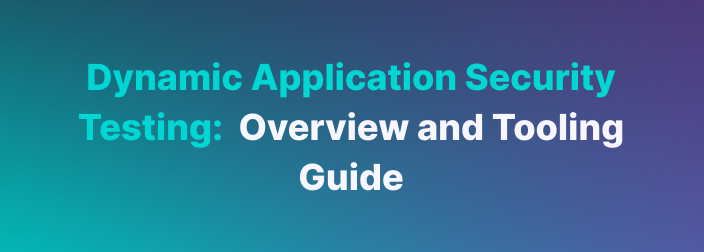Keeping up with every vulnerability that could impact your code and applications can be a lot of work. Creating an application comes first for most developers, and securing it becomes a secondary priority. It's no surprise since many teams, especially in older organizations, approach web-app/application security testing in the later phases of development, and a completely separate team handles this testing. Enter the realm of modern development practices, and you'll see that many development and AppSec teams are using automated tooling to make security an automated and highly prioritized part of the SDLC. Testing earlier and more often.
This shift-left approach requires many tools to create a holistic security testing stack. Within this stack, a plethora of various testing tools likely exist. So which ones do you choose? This blog will cover some of the top tools to help you build a modern and effective application security testing stack. Let's begin by digging into the fundamentals of security testing.
Introduction to Application Security Scanning
What is Application Security Scanning?
At the highest level, application security scanning identifies and addresses security vulnerabilities within web applications. Much of the time, developers and security teams can scan web-apps using automated tools to uncover potential security risks. By integrating application security scanning into the software development life cycle, organizations can ensure that their web applications are secure from the ground up, from when the first line of code is written through to the app running in production.
Importance of Application Security Scanning
Security breaches and issues can be costly in many ways. Security can positively or negatively impact an application, so application security scanning is a crucial component of any comprehensive security strategy. Here are a few factors that make application security scanning so critical:
Protection Against Cyber Attacks: By identifying and fixing vulnerabilities early in the SDLC, you can protect your applications from being exploited by malicious actors.
Compliance: Many security regulations and standards (such as PCI-DSS, GDPR, and ISO-27001/ISO-27002) require regular security assessments to ensure your company remains compliant. Application security scanning helps ensure that your web applications comply with these requirements.
Proactive Risk Management: By addressing vulnerabilities before they are exploited, you can significantly reduce the risk of data breaches and other security incidents.
Web Application Security Risks
Common Web Application Vulnerabilities
Web applications are often targeted by attackers due to various common vulnerabilities. Understanding these vulnerabilities is the first step in protecting your applications. Some of the most frequent vulnerabilities include:
Cross-Site Scripting (XSS): This occurs when attackers inject malicious scripts into web pages viewed by other users, potentially stealing session tokens or other sensitive information.
SQL Injection: Attackers exploit this vulnerability by inserting malicious SQL queries into input fields, which can lead to unauthorized access to the database.
Cross-Site Request Forgery (CSRF): This tricks users into executing unwanted actions on a web application where they are authenticated, leading to unauthorized actions.
Remote Code Execution (RCE): This vulnerability allows attackers to run malicious code remotely on a server or system, potentially taking full control of the targeted application or infrastructure.
Local File Inclusion (LFI): In this attack, malicious actors exploit vulnerable code to include unauthorized files from the local server, potentially exposing sensitive information or executing unintended scripts.
Types of Application Security Testing
To ensure comprehensive security, it’s important to understand the different types of application security testing. Each type offers unique benefits and focuses on different aspects of your application’s security.
Static Application Security Testing (SAST)
Static Application Security Testing (SAST) solutions, such as Snyk and GitLab, involve analyzing your source code for security vulnerabilities. This type of testing looks specifically at how your application is designed and coded and does not require it to be running.
Benefits:
Early Detection: Identifies security flaws early in the secure software development process, allowing developers to fix issues before the code is deployed.
In-Depth Analysis: Provides a thorough examination of the codebase, helping to ensure that security is built into the application from the start.
Dynamic Application Security Testing (DAST)
Dynamic Application Security Testing (DAST) platforms, such as StackHawk, involve testing your web applications for security vulnerabilities while they are running. This type of testing simulates attacks and exploitation on the live application.
Benefits:
Real-World Simulation: By mimicking the expected behavior of an attacker, DAST scans help identify vulnerabilities as if they have been discovered by a threat hunter or attacker
Comprehensive Coverage: Detects security issues in the running environment, including configuration errors and runtime vulnerabilities that might be missed by SAST tools.
Interactive Application Security Testing (IAST)
IAST combines elements of both SAST and DAST to provide a more comprehensive analysis of your applications. It involves analyzing source code and testing running applications for security vulnerabilities.
Benefits:
Holistic Approach: Offers a comprehensive view of security by combining static and dynamic analysis techniques.
Real-Time Feedback: Provides immediate feedback on security vulnerabilities, helping developers to address issues more quickly.
Web Application Scanning Tools Comparison
Choosing the right web application scanning tool is crucial for effective security. Below you can find a comparison of some of the most popular tools available, highlighting their key features and benefits.
StackHawk
OWASP Top Ten: StackHawk's DAST scanner detects vulnerabilities in the OWASP Top Ten, providing coverage of the most critical security risks in modern web applications.
Simple Setup: StackHawk is designed to be easy to set up and configure, reducing the barrier to entry for incorporating security testing into the development workflow.
Collaboration Tools: It can integrate with collaboration tools like Jira and Slack, facilitating communication and tracking of security issues within development and operations teams.
Qualys Web Application Scanning
Comprehensive Scanning: Qualys offers an in-depth analysis of web applications, identifying a wide range of vulnerabilities.
Compliance Assurance: Helps ensure that your web applications comply with security regulations and standards.
Detailed Reporting: Provides detailed reports that help prioritize vulnerabilities based on risk, making it easier to address critical issues first.
Tenable Web App Scanning
User-Friendly Interface: Tenable is known for its ease of use, making it accessible for both beginners and experienced security professionals.
Effective Vulnerability Detection: Identifies security vulnerabilities efficiently, helping to protect web applications from potential threats.
Regulatory Compliance: Assists in meeting various compliance requirements by providing thorough security assessments.
Other Web Application Scanning Tools
OWASP ZAP: An open-source tool that offers a variety of features for finding security vulnerabilities in web applications. It’s especially popular among developers and security enthusiasts due to its flexibility and extensive documentation.
Burp Suite: A comprehensive platform for web application security testing, Burp Suite is known for its powerful scanning capabilities and its suite of tools designed for penetration testing.
Nuclei: A fast, customizable tool for finding security vulnerabilities using community-contributed or custom self-built templates. Nuclei is highly flexible and suitable for a range of security testing scenarios, from simple scans to complex assessments.
Using Web Application Scanning Tools
When selecting security tools, there are several factors which might impact your tool selection . These include the experience level of your internal security team and whether you are fully utilizing any existing tools that you already pay for. It’s crucial to match the tools with your specific security testing requirements and ensure they integrate well with your current development and operations workflows.
Scalability to support future growth, the quality of support and documentation, and the frequency of updates to address emerging threats are also important. Additionally, consider the overall cost-effectiveness relative to your security budget. The chosen tool should be easy to use, have a manageable learning curve, and integrate seamlessly into your team’s daily operations to avoid significant disruptions. Below are some additional factors to consider:
No Setup Required: Many modern web application scanning tools require minimal setup, allowing you to start scanning immediately. This is particularly beneficial for teams that need to quickly implement security measures.
Scheduling Scans: Most tools offer the ability to schedule scans to run automatically. Regularly scheduled scans help ensure that your web applications are continuously monitored for new vulnerabilities.
API Access and Integrations: Many scanning tools provide API access and can be integrated with other security systems and tools. This integration capability allows for streamlined workflows and comprehensive security management.
Web Application Scanning Reports and Results
Interpreting scan results and acting on them is a crucial part of maintaining the security of your web applications. This section will guide you through understanding scan results, prioritizing vulnerabilities, and implementing remediation strategies.
Understanding Scan Results
Vulnerability Details: Each detected vulnerability will include a description, potential impact, and recommended remediation steps.
Severity Levels: Vulnerabilities are typically categorized by severity (e.g., critical, high, medium, low). This should be used as a guide to help you prioritize which issues to address first.
Affected Components: Reports will indicate which parts of your application are affected, helping you pinpoint the exact locations of vulnerabilities in your codebase and applications.
Prioritizing Vulnerabilities
Not all vulnerabilities pose the same level of risk. It’s important to prioritize vulnerabilities based on their potential impact and the likelihood of exploitation. Consider the following factors:
Severity: Focus first on critical and high-severity vulnerabilities that could have the most significant impact if exploited.
Exposure: Prioritize vulnerabilities in publicly accessible parts of your application, as these are more likely to be targeted by attackers.
Business Impact: Consider the potential business impact of each vulnerability, including potential data breaches, downtime, and regulatory compliance issues.
Remediation and Mitigation
Addressing identified vulnerabilities promptly is crucial for maintaining application security. Here are some strategies for effective remediation and mitigation:
Fix the Code: Work with developers to fix vulnerabilities in the source code, following secure coding practices.
Apply Patches: Ensure that all software components, including third-party libraries, are up-to-date with the latest security patches.
Implement Workarounds: In some cases, temporary workarounds may be necessary until a permanent fix can be applied. For example, you might restrict access to a vulnerable feature or apply configuration changes to mitigate the risk.
Web Application Security for DevOps
Integrating web application security into your DevOps pipeline ensures that security is a continuous, integral part of the development process. This approach, often referred to as DevSecOps, aims to bridge the gap between development and security teams, fostering collaboration and automating security testing. Here’s how you can incorporate web application security into your DevOps practices.
Integrating with DevOps Pipelines
To ensure that security checks are performed consistently and efficiently, integrate web application scanning tools directly into your DevOps pipelines. Here’s how:
Continuous Integration (CI): Incorporate security scans as part of the CI process. This means that every time code is committed or merged, automated security scans are triggered, identifying vulnerabilities early.
Continuous Deployment (CD): Ensure that security scans are part of the deployment process. This ensures that any vulnerabilities are caught before the application is released to production.
Automated Testing: Automate security tests alongside functional and performance tests. This creates a holistic testing environment where security is continuously monitored.
Immediate Feedback: Provide developers with real-time feedback on security issues, enabling them to address vulnerabilities promptly during the development process.
Improving Collaboration Between Dev and Security Teams
Effective communication and collaboration between development and security teams are crucial for the success of DevSecOps. Here are some strategies to improve this collaboration:
Shared Goals and Metrics: Establish common goals and metrics for both teams. For example, aim to reduce the number of vulnerabilities or ensure all critical issues are addressed within a certain timeframe.
Cross-Functional Training: Encourage cross-functional training so that developers understand security principles and security teams are familiar with the development process.
Collaborative Tools: Use collaborative tools and platforms that allow both teams to share information, track vulnerabilities, and monitor remediation efforts.
Web Application Security for Cloud Security
As organizations increasingly adopt cloud-based services, ensuring the security of web applications in the cloud becomes paramount. This section discusses how to effectively scan, secure, and protect cloud-based web applications.
Scanning Cloud-Based Web Applications
Cloud environments introduce unique challenges and opportunities for web application security. Here’s how to approach scanning cloud-based applications:
Cloud-Native Tools: Use cloud-native security tools provided by your cloud service provider (CSP), such as AWS Inspector, Azure Security Center, or Google Cloud Security Command Center. These tools are designed to integrate seamlessly with your cloud environment.
Regular Scans: Schedule regular security scans to continuously monitor your cloud-based applications. This helps identify and address vulnerabilities as they arise.
Configuration Checks: Ensure that your cloud configurations are secure by regularly scanning for misconfigurations, which are a common source of security vulnerabilities in the cloud.
Ensuring Cloud Security Compliance
Compliance with cloud security regulations and standards is crucial for protecting sensitive data and avoiding penalties. Here are some steps to ensure compliance:
Understand Regulations: Familiarize yourself with relevant cloud security regulations and standards, such as GDPR, HIPAA, and PCI DSS. Each has specific requirements for data protection and security.
Automated Compliance Checks: Use automated tools to check for compliance with these regulations. Many CSPs offer built-in compliance checks and reporting tools.
Continuous Monitoring: Implement continuous monitoring to ensure ongoing compliance. This includes real-time alerts for any compliance violations and regular audits.
Protecting Cloud-Based Data
Protecting data in the cloud requires a multi-faceted approach. Here are some best practices:
Data Encryption: Encrypt data both at rest and in transit. This ensures that even if data is intercepted or accessed without authorization, it remains unreadable.
Access Controls: Implement strict access controls and use identity and access management (IAM) tools to ensure that only authorized users can access sensitive data.
Regular Backups: Perform regular backups of your data to prevent loss due to breaches, failures, or other incidents. Ensure that backups are also securely stored and encrypted.
By effectively scanning cloud-based web applications, ensuring compliance with relevant regulations, and protecting cloud-based data, you can significantly enhance the security of your applications in the cloud.
Web Application Security for Enterprise Security
Enterprise environments present unique challenges and opportunities for web application security. With larger and more complex infrastructures, it’s crucial to scale security measures effectively and manage risks across the entire organization. Here’s how to approach web application security in an enterprise setting.
Scaling Web Application Security
Centralized Security Management: Use centralized tools for monitoring and managing security across all web applications.
Automated Security Processes: Automate tasks like scanning, patch management, and compliance checks to handle scale efficiently.
Resource Allocation: Ensure security teams have the necessary tools, personnel, and training.
Managing Web Application Security Risks
Risk Assessment: Regularly identify and evaluate potential security threats.
Risk Prioritization: Focus on the most critical vulnerabilities first.
Incident Response Plans: Develop and test plans for quick and effective incident responses.
Ensuring Enterprise-Wide Security
Security Training and Awareness: Regularly train employees on security best practices and threat recognition.
Secure Development Practices: Integrate secure coding practices and use SAST and DAST tools.
Continuous Monitoring and Improvement: Monitor threats in real time and use insights to improve security measures.
Next Steps for Improving Web Application Security
Implement a Web Application Scanning Tool: Choose a tool that fits your organization's needs and integrate it into your security strategy.
Integrate Security into DevOps Pipelines: Ensure security is a continuous part of the development process by incorporating automated scans and real-time feedback.
Improve Collaboration: Foster better communication and collaboration between development and security teams to ensure security is built into every stage of the application lifecycle.
Conclusion
Application security scanning is essential for identifying and addressing vulnerabilities in web applications using automated tools. By employing SAST, DAST, and IAST, we can achieve a comprehensive analysis through the combination of static and dynamic testing. Effective scanning with tools like Qualys, Tenable, OWASP ZAP, Burp Suite, and Nuclei ensures compliance and protects against cyber threats.
When it comes to utilizing DAST for web applications and the APIs that power them, StackHawk is a great platform to adopt. StackHawk's modern DAST platform empowers developers and AppSec teams to easily test their applications and remedy any vulnerabilities with customized insights and easy-to-follow reports. Scanning applications locally or in CI/CD gives flexibility for developers to test their code manually as they write it and automatically when pushed into source control. Want to try out StackHawk for yourself? Sign up today for a 14-day free trial.



